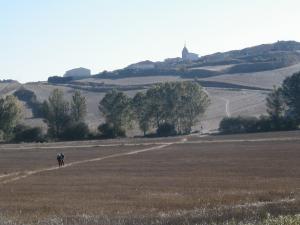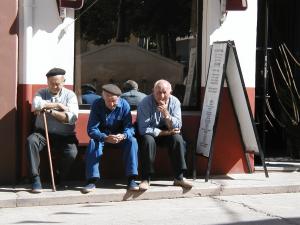“I started walking in Geneva,” said the light-haired woman with a guitar strapped to her backpack. Surely not Geneva, Switzerland, I thought as I asked, “Where’s that?”
This 23-year-old Australian had been walking for five weeks and was just one of the many Spanish and foreign walkers I met on the Camino de Santiago, or Way of St. James, an ancient pilgrimage route through northern Spain.
Background

[social]
In the ninth century, while searching for a source of a strange light, a religious hermit found the forgotten tomb of St. James in a dense forest near present day Santiago de Compostela. Apparently, after James’ death, two disciples gathered his remains and sailed them back to Galicia in northwestern Spain in a stone boat. It was after this discovery that pilgrims started embarking on the journey to Santiago.
Although the Camino Frances, the most authentic to Santiago’s actual route across northern Spain, is the oldest and most popular walking path through Europe, many others exist. The Camino Portugues and Via de la Plata leading north from Portugal and Seville respectively, are just a couple. Most of the others are paths from the rest of Europe that lead into the Camino Frances. It is sort of an “all roads lead to Rome” situation. Some ultra-dedicated pilgrims start their pilgrimage right from their doorstep, in the manor that medieval pilgrims did. Others start from the Vatican, or even Jerusalem. For those starting in any part of Europe, there are four major arteries in France onto which walkers can connect. The most common starting point today is at the French-Spanish border, where it is possible to make the pleasant 500-mile walk to Santiago de Compostela in six to eight weeks.
Walking trail – unlike the U.S.
This walking trail phenomenon is unlike that which we have in the United States. Our trails, like the famous Appalachian Trail stretching from Maine to Georgia, do not stray far from the wilderness, passing few small towns, and requiring the hiker to be self sufficient with food and shelter for weeks at a time. But in Europe, a hiker infrastructure exists in the form of special walker-only places to stay and food service in towns along the way. There are very few stretches of more than ten miles without a town to get the necessary food or lodging for the night. So while there is little wilderness along the European paths, there is plenty of agriculture, history, culture and locals.
These walker accommodations, known as albergues or refugios are reserved for people traveling on foot. Most will allow bicycle tourists to stay, if at the end of the day there is space still available. There are no reservations – you simply show up and claim one of the open bunk beds by laying out your sleeping bag. Many, managed by municipalities and volunteer groups, charge about $5.00 U.S., but some only ask for a donation. They are simple and spartan, and usually clean. The highest concentrations of these albergues are along the Camino in Spain, but they do exist in France and less commonly in the rest of Europe. In most European towns, there is some form of inexpensive lodging, be it a traditional hostel or a family run hotel.
Two Dutch men I met along the Camino in Spain had left from their home in the Netherlands two and a half months prior. Still happy and healthy, although with blistered feet, they showed us their almost-filled credencial del peregrine, or pilgrim’s accreditation card. The credencial is a passport-like document issued at the beginning of your journey that proves you are a pilgrim, and have been walking on a daily basis. It is necessary for admittance into the albergues. Thus, the credential soon becomes a pilgrim’s most important possession, second only after the official passport.
What’s the attraction?
So what is the attraction to blistery feet, community lodging, and the scorching Spanish sun? Many modern day pilgrims come to the Camino for religious or spiritual reasons. More often, though, pilgrims are in some sort of life crises, in between careers or relationships, or searching for something more in life. Others come for the centuries of rich history and culture that Spain is so famous for. Some simply come for the joy of walking and the simplicity of a pilgrim’s life.
The Camino doesn’t discriminate – you will find every age and nationality walking. On my journey, I was fortunate to spend a few days with the first Malaysian to complete the pilgrimage. For a week I walked side by side with a Brazilian in a mid-life crisis. Separated from his wife with a child, we were walking for similar reasons, but in very different circumstances. Yet, we bonded over a couple hundred miles together.
Despite their reasons, all pilgrims are issued their credencial at their starting point. This gets stamped each night and sometimes at churches and other monuments along the way. I got mine at the Abby in Roncesvalles, one of the two popular starting places for the Camino Frances.
In medieval times
In medieval times, the pilgrim walked from his or her home to Santiago and back. At the end of the pilgrimage, a compostela was issued, which gave accreditation that the pilgrim had reached Santiago, and had done so for religious or spiritual reasons. Many of the pilgrims were walking as penance in order to be forgiven for certain sins. However, other medieval pilgrims may have just been curious about what was ahead from home, since traveling was not a practical pastime in those days. Despite various reasons, they faced many dangers and hardships along the way. Robbers and wild animals were the biggest concern. Sickness and disease could also easily ruin a pilgrimage. For this, an infrastructure – hospitals, hospices and fortresses were built – some of which can still be seen.
Today you can tour the castle in Ponferrada, started in the 12th century by the Knights Templar in order to protect pilgrims. Much of it is in ruins now, a climb around its high walls affords nice views of the city and surrounding mountains. Its striking architecture and long history were a welcome mid-day break on a 22-mile day for me. In the hamlet of San Juan de Ortega lies the bones of the village’s namesake, who dedicated his 12th century life to building and maintaining the roads, bridges and hospitals along the route. Modern day travelers pass over many of these medieval bridges, there is even a stretch of Roman road preserved.
Not only are the places along the Camino memorable, but also the people. Some of these characters become famous among the pilgrim community. One Englishman drives his RV from Britain every April in order to make what he calls a “pilgrim pit-stop”. Everyday he parks his RV somewhere different and stops passers-by to offer water, soda, coffee and beer, collecting only a donation. When October comes, he packs up and returns home for the winter.
Another man – a Spaniard named Tomas – is the most prominent and only permanent resident of the former village of Manjarin. Years ago he left his family and career in Madrid to dedicate his life to hosting pilgrims in his mountain-top dwelling known as “the hippie place”. Located near a remote mountain pass where the weather often turns foul, Tomas graciously opens his home to walkers and even serves a supper complete with wine. What Tomas’ place lacks in amenities and cleanliness, is made up in character. After eating the evening meal and enjoying conversation in a multitude of languages, I slept on a ripped mattress in the attic next to a 77-year-old Austrian woman, a German, a Swiss and two young French men.
If all of this sounds overwhelming, don’t panic, there are guidebooks out there, available in several languages, including English. Besides this, there’s a wealth of information on the web.
If you go
To get there, I flew to Barcelona and bused to Roncesvalles, my starting point. But it is just as easy to fly to Madrid.
Summer is a good time since all the albergues are operational. To avoid the summer heat and overcrowded accommodations, try the spring or fall. Although it is possible, few go in winter. It will not be crowded, but it will be cold and some albergues may not be open.
What to bring
To walk the Camino, you’ll need a medium-sized backpack, good walking/hiking shoes, a sleeping bag, and appropriate clothes for the season.
Most people allow six to eight weeks to walk the 500 miles from the French-Spanish border. Because there are no rules, pilgrims should not feel any shame in catching a bus occasionally between cities if they are fatigued, injured or falling behind pace. The route is well marked, a guidebook is not necessary. However, many pilgrims like to carry one in order to read explanations about the history of the hamlets and cities along the way. A good one in English is Walking the Camino de Santiago by Bethan Davies and Ben Cole. Knowing Spanish would be helpful, but not necessary if you carry a phrase book. Check the Web for more information. Buen Camino!
Book your flights to Spain, find hotels in Spain, or read about things to do in Spain.

